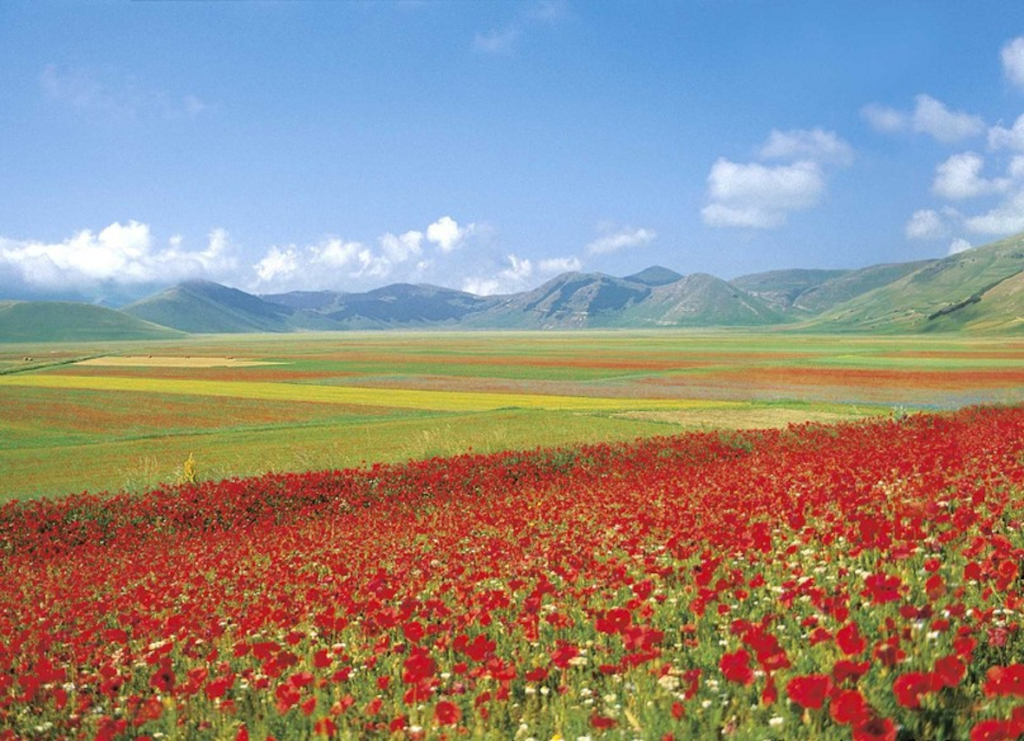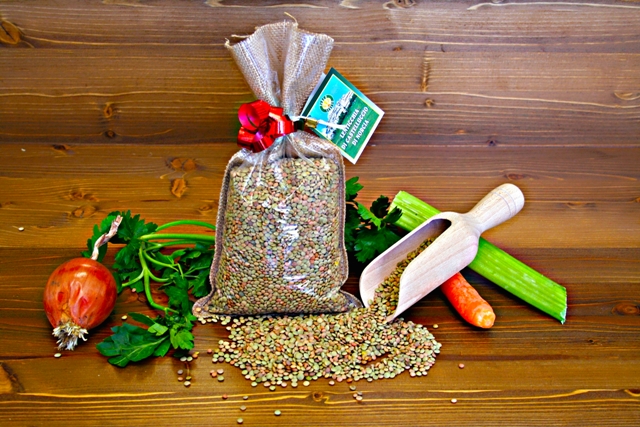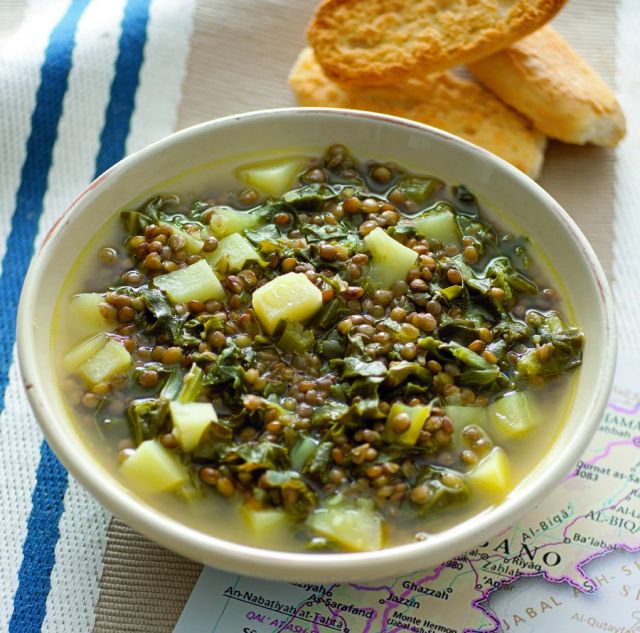 It is so small that it does not even look like a lentil; so tasty that it does not taste like a legume; so natural that it is appreciated even with a few drops of olive oil. The unmistakable flavour of the lentils produced at Castelluccio was born in Umbria, at an altitude of m 1500, in the heart of the National Park of Monti Sibillini. This lentil is sown as soon as the snow melts and it is the protagonist of the ‘Festa della Fioritura’, which during the last weeks of June offers an amazing floral show. After receiving the European IGP acknowledgement, local producers are committed to preserve the genuine cultivation techniques which do not involve the use of chemical fertilizers. The Lentil of Castelluccio is unique for its polychrome appearance, too, which ranges from striped look to the different types of yellow, down to the delicate or intense shades of brown.
It is so small that it does not even look like a lentil; so tasty that it does not taste like a legume; so natural that it is appreciated even with a few drops of olive oil. The unmistakable flavour of the lentils produced at Castelluccio was born in Umbria, at an altitude of m 1500, in the heart of the National Park of Monti Sibillini. This lentil is sown as soon as the snow melts and it is the protagonist of the ‘Festa della Fioritura’, which during the last weeks of June offers an amazing floral show. After receiving the European IGP acknowledgement, local producers are committed to preserve the genuine cultivation techniques which do not involve the use of chemical fertilizers. The Lentil of Castelluccio is unique for its polychrome appearance, too, which ranges from striped look to the different types of yellow, down to the delicate or intense shades of brown.
Naturally organic
Thanks to the very harsh climatic conditions in which it is born, the lentil of Castelluccio is the only legume which does not need to be treated for preservation, because it is not attacked by insects which feed on legumes. The lentil of Castelluccio has an extraordinary resistance to drought as well as cold of the long winters which characterize Italian Apennines. Also thanks to its characteristics of resistance to climate, this small lentil becomes a concentrate of both proteins and minerals. Scientific researches have confirmed its important nutritional value, useful for people who need a diet rich in iron, potassium, and phosphorus, low in fats, and very nutritious. Its skin, especially fine and tender, allows cooking the product directly, without soaking it as it is necessary to do with other legumes, also allowing preserving both its flavour and nutritional properties.
To nature, local producers have associated the latest technology equipment, in order to control the process of cleaning and packaging of the lentils. Electronic weighing scales, optical sorters, x -ray machine, and metal detector guarantee the absence of any kind of impurity within the packaged goods. Whenever an error occurs, or the presence of a foreign body in a lot of goods is detected, the procedures specified in the self-control plan are started.
 Castelluccio, a suggestive hamlet of the famous municipality of Norcia, can be reached through a panoramic drive which offers spectacular mountain and high hill sceneries. It was built in the thirteenth century, but its history has more ancient origins, as evidenced by the findings of some objects dating back to the Roman period which bear witness to the cultivation of lentil for some millennia. On the slopes of the Monte Vettore there is ‘Piangrande’, a vast plain where the Castelluccio lentils and other legumes are cultivated. In the days leading up to the summer, this region is coloured with many flowers characterized by different tones, which create a series of unique shades. The summer is very short, with abrupt temperature change between day and night. The shape of the valley, which derives from a large mountain lake, accentuates these climatic properties. The soil results to be rich in organic material and limestone, which are at the roots of the strong flavour of this lentil.
Castelluccio, a suggestive hamlet of the famous municipality of Norcia, can be reached through a panoramic drive which offers spectacular mountain and high hill sceneries. It was built in the thirteenth century, but its history has more ancient origins, as evidenced by the findings of some objects dating back to the Roman period which bear witness to the cultivation of lentil for some millennia. On the slopes of the Monte Vettore there is ‘Piangrande’, a vast plain where the Castelluccio lentils and other legumes are cultivated. In the days leading up to the summer, this region is coloured with many flowers characterized by different tones, which create a series of unique shades. The summer is very short, with abrupt temperature change between day and night. The shape of the valley, which derives from a large mountain lake, accentuates these climatic properties. The soil results to be rich in organic material and limestone, which are at the roots of the strong flavour of this lentil.An european guarantee
As this is an unique product in the world, in order to safeguard the consumers in an effective way and protect this product against possible counterfeits, in 1997 the European Community conferred to the Castelluccio lentils the IGP - Protected Geographical Indication acknowledgement, so solving the problem of the presence of small lentils which do not come from this hamlet, sold as ‘Castelluccio lentils’. The brand, on every packaging, allows differentiating this product at the best, making it a must for Italian and international cuisine.
The export
The area planted with lentils consists in about 250 acres, with an average annual production of about 2,000 quintals. These are small numbers, but this cultivation receives great attention by international markets, too. Germany, Austria, and Switzerland are the main importing Countries, with Russia which year after year wins more and more space.
The high attention paid by consumers to the Castelluccio lentils has led them in the domain of luxury organic products, where luxury does not mean high price, but limited production in both quantity and time.
A natural packaging
 Mainly jute and cardboard are used for the packaging, which must guarantee the unalterability of the characteristics of taste and naturalness of the lentils. They are marketed in packages whose weight is of g 250, g 500, or kg 1, they must have a specific sealant cover, in order to avoid that the contents can be touched, if the seal is not broken. The words ‘Lenticchia di Castelluccio di Norcia’ and the IGP must be indicated in printing of the same size, in addition to manufacturer's name and the year of production.
Mainly jute and cardboard are used for the packaging, which must guarantee the unalterability of the characteristics of taste and naturalness of the lentils. They are marketed in packages whose weight is of g 250, g 500, or kg 1, they must have a specific sealant cover, in order to avoid that the contents can be touched, if the seal is not broken. The words ‘Lenticchia di Castelluccio di Norcia’ and the IGP must be indicated in printing of the same size, in addition to manufacturer's name and the year of production.

